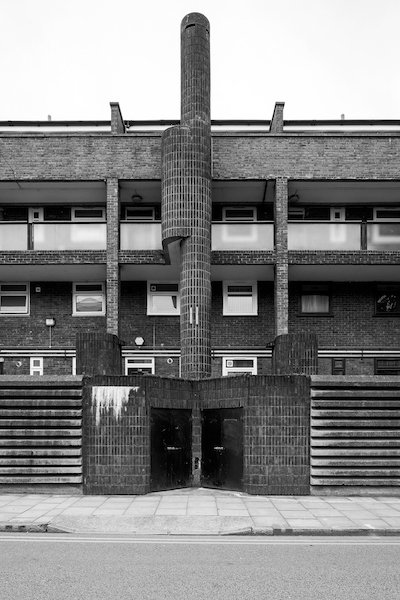
Brutalism is back in vogue. Trellick Tower — once infamously branded the 'Tower of Terror' — is now rehabilitated and domiciled, its iconic image on plates and scatter cushions sold on trendy markets.
Now we've come to love the iconic, it's time to explore further deeper. We asked brutalist lover Simon Phipps to show us some favourites, featured in his book Brutal London. He picked out eight lesser-known buildings across London that, for the most part, quietly continue the job they were purposed for by the welfare state, while retaining a glimmer of the optimism and hope for the future that originally informed the design.
Holmefield House
Holmefield House sits forgotten in the shadow of the famous Trellick Tower. It retains its own individuality, with a large, wide base as opposed to Trellick's daunting height. The long, low, white sand-lime brick structure with geometric motifs picked out in blue tiles sits assuredly. It even has a nautical quality with its funnel-like service towers, jutting out.
Kensal Road, North Kensington, W10. Built late 1960s

Lincoln Court
The three point blocks comprising Lincoln Court, elevated by concrete pilotis and flanked by raised terraces, sit elegantly alongside Stoke Newington's East Reservoir.
Bethune Road, N16. Built 1969

Eros House
Eros House was designed by Rodney Gordon whose work includes two brutalist icons; Trinity Square in Gateshead and the Tricorn in Portsmouth. Both have been demolished by philistine local authorities. Sadly, Eros House hasn't fared much better. Although still standing, its front and rear elevations are now clad in tacky vinyl panels, which utterly destroy the deeply modelled composition of projecting bays that once gave the building its vigour. Thankfully, the external stair tower to the front of the building survived this vandalism and to the rear is a highly sculptural and expressionistic concrete spiral staircase.
Brownhill Road, Catford, SE6. Built 1960-63

Oakshott Court
Oakshott Court looks positively ordinary at a glance from behind. But if you wander round the other side you'll see the fronts are stepped sections with deck access walkways running through, diagonal steps and a cylindrical drum tower. This polarisation of the front and back typifies Camden housing in the 1970s.
Polygon Road, Somers Town, NW1. Built 1976

Middlesex Street Estate
There's an odd rhythm to the slotted concrete balconies that adorn the outside of the Middlesex Street Estate. They contrast well with the dark engineering brick that forms the core of the building. Within the estate there are tranquil landscaped garden and seating areas for residents of this thoroughly urban development.
Middlesex Street, City of London, E1. Built 1965-75

Arden Estate
This is one of the largest and most striking of Leonard Manasseh's housing projects. To the front, thin brick piers support elevated brick blocks with single rectangular windows, while to the rear piers contrast the horizontal venting broken intermittently by the extraordinary refuse chutes.
Hoxton Road, N1. Built 1968-72

Ashington House
Noel Moffett conceived Ashington House as a means of satisfying the requirement for much needed high-density housing in Bethnal Green. The outcome was remarkable. The asymmetrical composition combines flying buttresses of exposed aggregate concrete, staggered covered stairs, stacked hexagonal units and more, all in brooding dark brown brick and exposed concrete. The effect is individualistic, sculptural and even gothic.
Barnsley Street, Bethnal Green, E1. Built 1971

Weston Rise Estate
Even though it's situated on what is effectively a huge traffic roundabout, and imprisoned within a recent decoratively crimped high blue fence, Weston Rise is enduringly impressive. Conceived by John Partridge of HKPA, the estate comprises a series of forcefully modelled brutalist blocks that descend an acutely steep site. The blocks angle down the hill pivoting around stair towers of concrete to heroic effect.
Pentonville Road, Finsbury, N1. Built 1965-69
All photos are by Simon Phipps, the author of Brutal London (September Publishing).
Find Simon on Twitter and Instagram @new_brutalism




